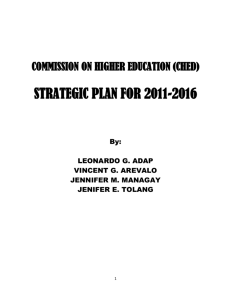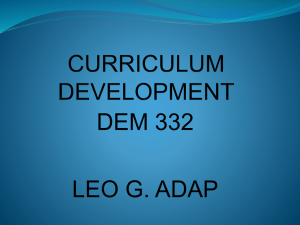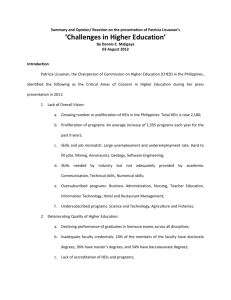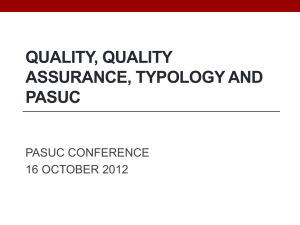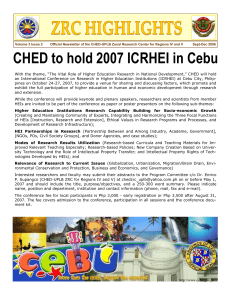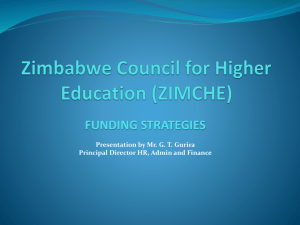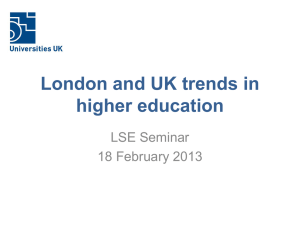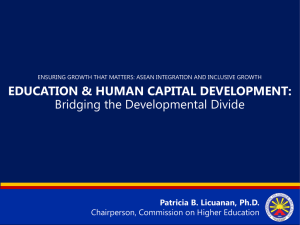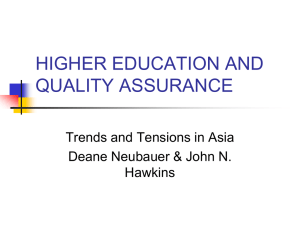Dr. Rosita L. Navarro, President of Centro Escolar University
advertisement
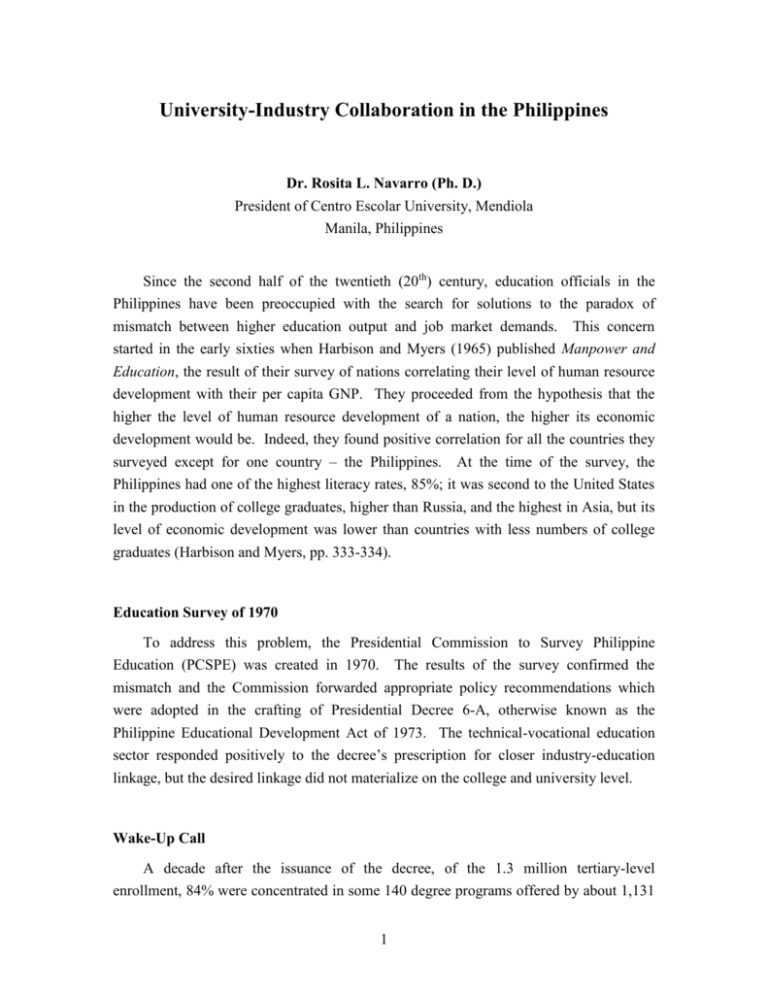
University-Industry Collaboration in the Philippines Dr. Rosita L. Navarro (Ph. D.) President of Centro Escolar University, Mendiola Manila, Philippines Since the second half of the twentieth (20th) century, education officials in the Philippines have been preoccupied with the search for solutions to the paradox of mismatch between higher education output and job market demands. This concern started in the early sixties when Harbison and Myers (1965) published Manpower and Education, the result of their survey of nations correlating their level of human resource development with their per capita GNP. They proceeded from the hypothesis that the higher the level of human resource development of a nation, the higher its economic development would be. Indeed, they found positive correlation for all the countries they surveyed except for one country – the Philippines. At the time of the survey, the Philippines had one of the highest literacy rates, 85%; it was second to the United States in the production of college graduates, higher than Russia, and the highest in Asia, but its level of economic development was lower than countries with less numbers of college graduates (Harbison and Myers, pp. 333-334). Education Survey of 1970 To address this problem, the Presidential Commission to Survey Philippine Education (PCSPE) was created in 1970. The results of the survey confirmed the mismatch and the Commission forwarded appropriate policy recommendations which were adopted in the crafting of Presidential Decree 6-A, otherwise known as the Philippine Educational Development Act of 1973. The technical-vocational education sector responded positively to the decree’s prescription for closer industry-education linkage, but the desired linkage did not materialize on the college and university level. Wake-Up Call A decade after the issuance of the decree, of the 1.3 million tertiary-level enrollment, 84% were concentrated in some 140 degree programs offered by about 1,131 1 colleges and universities. Earlier, a high school diploma was sufficient to land one on higher paying white-collar jobs, but as more college graduates entered the work force, the desire for the college diploma became stronger for one to be competitive. With competition tough in the local job market, Filipino technicians and skilled workers gravitated to the foreign job market which, in 1982 employed about 800,000 Filipino overseas contract workers in more than 100 countries. The continuing large-scale production of college graduates resulted in the phenomenon of the educated unemployed and under employed in the Philippines. Education Act of 1982 To provide legal backbone to the Philippine Educational Development Act of 1973, the legislature enacted Batas Pambansa 232, otherwise known as the Education Act of 1982 which mandated, among others, that tertiary education should pursue the following objectives: 1. to provide a general education program that will promote national identity, cultural consciousness, moral integrity and spiritual vigor; 2. to train the nation’s manpower in the skills required for national development; 3. to develop the profession that will provide leadership for the nation; 4. to advance knowledge through research work and apply new knowledge for improving the quality of human life and responding effectively to changing societal needs and conditions. Need for Drastic Reforms The number of surplus college graduates, however, continued to grow. The overflow was absorbed in foreign job placements that did not require college education. The phenomenal brain drain occurred in the Philippine employment scenario, putting more strain on the nation’s economy. In 1989, the Joint Resolution No. 2 of the Congress of the Philippines created the Congressional Commission on Education (EDCOM) which undertook an incisive, comprehensive look into Philippine Education and submitted in 1991 its report entitled “Making Education Work: An Agenda for Reform”. 2 Acting on the Congressional Commission on Education (EdCOM) recommendations, the Philippine Congress enacted in 1994 two landmark educational legislations: R.A. 7722 creating the Commission on Higher Education (CHED) and R.A. 7796 creating the Technical Education and Skills Development Authority (TESDA). Thus, in effect, the humongous Department of Education that used to manage all levels of education in the Philippines was relieved of the post-secondary technical-vocational and tertiary levels and left to concentrate on basic education. On its first year, the Commission on Higher Education (CHED) identified its mission and goals in close consultation with leading public and private higher education institutions and professional organizations. Drawing heavily from the letter and substance of the law that created it, CHED finalized the vision, mission and strategic directions of Philippine higher education. Vision The higher education system of the Philippines is a key player in the education and integral formation of professionally competent, service-oriented, principled, and productive citizens. Through its tri-fold function of teaching, research and extension services, it becomes a prime-mover of the nation’s socioeconomic growth and sustainable development. Mission Guided by this vision and under the leadership of CHED, a dynamic and facilitative organization staffed by qualified and service-oriented personnel, higher education institutions that comprise the system shall: a. offer programs and services that meet the demands of an industrializing economy within the context of sustainable development and a culture of peace, as well as the challenges of a diverse and globalized society; b. nurture an academic environment that fosters integrated learning, creative and critical thinking, appreciation of cultural diversity and national identity, and inculcates moral values; c. conduct research to support instruction, create new knowledge, and enhance the quality of life in society; and 3 d. undertake extension programs and services that facilitate the transfer of technology, foster leadership and promote self-reliance among the less privileged in Philippine society. Strategic Direction CHED identified four (4) major goals and the strategies to achieve them. 1. Efficiency and Effectiveness a. Establish a policy and legal framework required for rationalization of the higher education system particularly the State Universities and Colleges (SUCs) b. Strengthen complementation and productive partnerships between and among public and private higher education institutions (HEIs), and between education and other sectors. c. Ensure optimal returns from the utilization of higher education resources. 2. Quality and Excellence a. Offer quality undergraduate and graduate education programs with standards comparable with those offered by leading international HEIs. b. Become a regional knowledge center in the Asia-Pacific region in selected disciplines particularly in areas where Philippine higher education institutions have a distinctive competitive edge. 3. Relevance and Responsiveness a. Generate, adapt and disseminate knowledge that equips graduates with competencies, values and skills vital in a dynamically changing domestic and international environment. b. Utilize state-of-the art and appropriate information and communication technology and other innovations in education. 4 4. Access and Equity Provide deserving and qualified Filipinos opportunities for affordable quality tertiary programs and services. Strides in Higher Education Up until the creation of the Commission on Higher Education, “laissez faire” pervaded the higher education scenario in the Philippines resulting in the unabated increase of private colleges and universities. The first six (6) years of CHED is characterized by organizational effort, planning, monitoring and guarded innovations. Table 1 shows the growth of higher education during the first six (6) years of CHED. Year Sector/Institutional Type 1994 1995 1996 1997 1998 1999 2000 PUBLIC 235 272 271 260 265 233 164 PRIVATE 950 1014 1045 1114 1118 1172 1189 Non-Sectarian 701 747 764 828 830 876 890 Sectarian 249 267 281 286 288 296 299 1185 1286 1316 1374 1383 1405 1353 TOTAL Table 1: Number of Higher Education Institutions by Sector/Institutional Type and Year 5 Figure 1 shows the distribution of higher education institutions as of May 2003. The total number of higher education institutions is 1,478 of which 1,305 are private while 174 are public. Of the private HEIs, 980 (66.30%) are non-sectarian while 325 (21.99%) are sectarian. State universities and colleges (SUCs) are 111 (7.51%). 44 (2.97%) local universities/colleges (LUCs) and 18 (1.22%) other HEIs. LUCs 2.97% Other HEIs 1.22% SUCs 7.51% PSs 21.99% PNs 66.31% Figure 1: Distribution of Higher Education Institutions (HEIs) by Type Legend: SUCs – State Universities and Colleges LUCs – Local Universities and Colleges PNSs – Private Non-sectarians PSs - Private Sectarians Other HEIs – include twelve (12) other government institutions, five (5) special HEIs and one (1) CHED supervised institutions 6 With the increase in the school-going population, enrollment in higher education also increased at an annual rate of 3.43%. In Academic Year 2000-2001 aggregate enrollment in colleges and universities reached 2,637,039 with 73.11% in private HEIs and 26.89% enrolled in public HEIs. The number of graduates likewise increased to 370,528 in Academic Year 1999-2001. Arcelo et al. (1982) placed at 84,000 the surplus educated graduates out of the total HEIs output of 140,000 during the year. It was estimated that there would be a surplus of a quarter of a million educated manpower at the turn of the 21st century. This surplus accounts not only for unemployment and underemployment but for manpower exodus in the United States, Canada, Australia, some countries in Europe and in the Middle East. Confronted with these realities and responding to the challenges of the new millennium, the Commission on Higher Education formulated the Long-Term Higher Education Development Plan: 2001-2010 with key results areas, performance indicators, and strategies along the four (4) goals of Philippine Higher Education: efficiency and effectivenesss, quality and excellence, relevance and responsiveness, access and equity. In pursuit of relevance and responsiveness, the ten-year plan identifies industry-academe partnership with targets of 30% of HEIs and 60% of HEIs having collaborative projects with industry by year 2005 and 2010, respectively. Private Initiatives in University—Industry Linkage Almost 1,000 private non-sectarian colleges and universities presently account for more than 1 million students in various degree programs. These private nonsectarian HEIs were established under the Corporation Law of 1906 and the Private Education Law of 1917. The CHED exercises supervision over these HEIs, issues permits and recognitions and monitors their compliance with the CHED policies and standards. They are wholly dependent on tuition fees for their operation and facilities build-up. Lately, about ten percent (10%) have enjoyed some degree of deregulation for obtaining Levels 2 and 3 Accreditation. Accreditation is the recognition that a program possesses quality that exceeds in varying degrees the minimum requirements set by CHED. At present, employability of graduates is accepted as indicator of the quality of college education. In the past fifty years private non-sectarian HEIs insure placement of their graduates through formal or informal agreements with business and industry in the last semester or school year of the degree program through partial or full immersion in 7 practicum or internship. Lately, more and more companies realize the value of agreeing to be cooperators in the practicum/internship of senior college students. Industry-university collaboration has proved beneficial to three sectors. For the students: Workplace orientation and opportunity to apply their skills, knowledge and proper work attitude. Enhanced employability Transportation allowance which some companies provide Better chances for career mobility For companies: Prospective workers are developed according to the companies’ specifications. Practicum students prove to be assets in the workplace. For schools: Reduced need for sophisticated equipment and facilities Responsiveness to industry needs. Better employment for graduates Enhanced public image. The private non-sectarian HEIs which enjoy Levels 2 and 3 accreditation status are able to incorporate their industry cooperators’ recommendations in their respective curricula. Technology providers, training hospitals, manufacturing firms, and companies in the service industry have started to lend their experts to serve as consultants in selected private colleges and universities. A few universities have already explored linkage with foreign-based companies for their senior students’ practicum. With this development we are optimistic that CHED may be able to reach its target of academe – industry linkages for 30% of HEIs in 2005 and 60% of HEIs in 2010, the end of the plan period. 8 Reference Arcelo, Adriano, Waldo Perfecto, Bikas Sanyal. Higher Education and the Labor Market in the Philippines. Paris: UNESCO, 1982. Education and Manpower Development Programs. Quezon City: Congressional Oversight Committee on Education, 1993. Harbison, Frederick H. Human Resources as the Wealth of Nations. New York: Oxford University Press, 1973. Harbison, Frederick and Charles Myers. Education, Manpower and Economic Growth. New York: McGraw-Hill Book Co., 1964. ----. Manpower and Education. New York: McGraw-Hill Book Co., 1965. Higher Education and the Labor Market: The Southeast Asian Experience. Manila: ASAIHL Philippine Council, 1984. Higher Education Research Papers. Pasig City: Commission on Higher Education (CHED), 2001. Long-Term Higher Education Development Plan: 2001-2010. Pasig City: CHED, 2001. Philippine Higher Education in the Twenty-First Century. Pasig City: The Task Force on Higher Education, CHED, 1995. Valisno, Mona D. (ed.). The Reform and Development of Higher Education in the Philippines. Pasig City: CHED, 2000. 9
